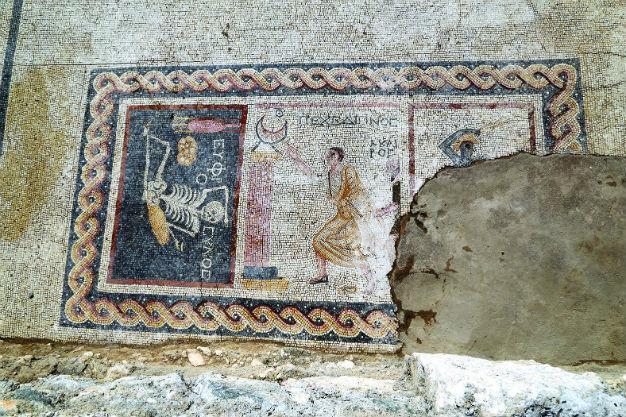Rare mosaic in Turkey's south arouses interest
HATAY – Doğan News Agency

AA photo
Turkish historian İlber Ortaylı has paid a visit to the excavation area in the southern province of Hatay’s İplik Pazarı district where an ancient mosaic reading “be cheerful, live your life” was discovered last week during the construction of a cable railway project.
Ortaylı said the mosaic was a very important and rare artifact, and a museum should be established at its excavation site to display the mosaic.
Speaking to press members in the excavation area, Ortaylı said Antakya, ancient Antiocheia, was home to lots of mosaics like this one, and continued:
“Many other big mosaics will be unearthed during excavations to be carried out in a row with the establishment of a new museum. Because senatorial families and rich people of the city lived here, they needed to prove their existence here. The patricians who lived in ancient Rome did not have to prove their existence with mosaic floors but people here had to. Many other artifacts will be found here. So this Mosaic Road Project is very important. This mosaic is highly important, too… In my opinion, it should be displayed in a new, separate museum.”
Hatay Metropolitan Mayor Lütfi Savaş said a museum would be built there to display the artifacts unearthed in the same site, and continued:
“The Mosaic Road Project started nearly three months ago. We have four cities that are rich in terms of mosaics. Hatay is one of them. We want to promote these four cities and create a destination [for tourism]. Not just with this mosaic but we have found many others in this area. We collected all of them and they are at the museum now. We are consulting experts while the museum is under construction. This mosaic and others will be displayed there.”
The mayor added that Italy also had a similar mosaic, “but it is an amateur one compared to ours.”
He said that they would also build an archaeology park and the project would be finished by March 2017.
‘Skeleton mosaic’
Called the “skeleton mosaic,” the newly discovered mosaic belonged to the dining room of a house from the 3rd century.
According to Demet Kara, an archaeologist from the Hatay Archaeology Museum, two things were very important for the Roman’s elite class in terms of social activities: bath and dinner. In the first scene, a slave or servant starts a fire, symbolizing the bath. In the middle scene, there is a sundial and a young man running towards it with a bare-headed butler following him. The sundial is set between 9 p.m. and 10 p.m., 9 being the time when baths were usually taken and 10 being supper time in the Roman period. The writing at the scene states he is late for supper, with some thoughts about time. In the last scene, there is a skeleton with a drinking vessel in his hand along with bread and a wine pot, with the words, “be cheerful and live your life.”
